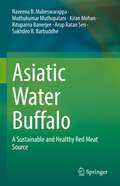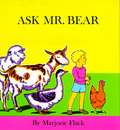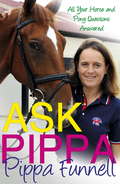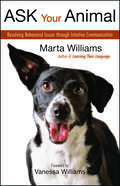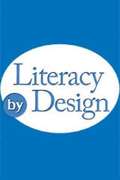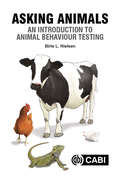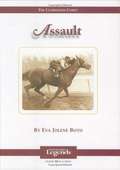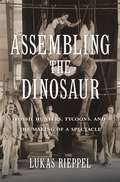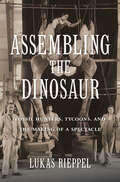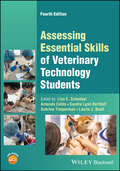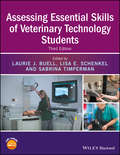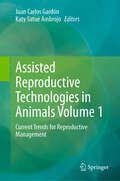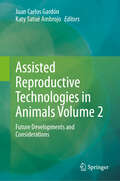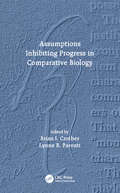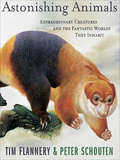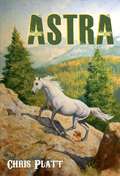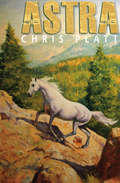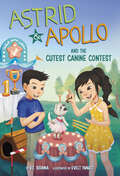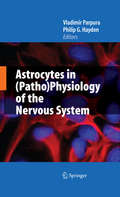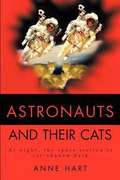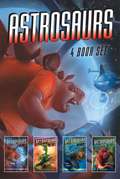- Table View
- List View
Asiatic Water Buffalo: A Sustainable and Healthy Red Meat Source
by Rituparna Banerjee Naveena B. Maheswarappa Muthukumar Muthupalani Kiran Mohan Arup Ratan Sen Sukhdeo B. BarbuddheThis need-based unique book deals exclusively with water buffalo (Bubalus bubalis) meat to provide much needed information to thousands of buffalo meat processors across the world. The information provided in this first-of-its-kind book on buffalo meat quality, nutritional characteristics, safety, and processing can be utilized by buffalo meat producers and meat processors for the advancement of the buffalo meat sector. It also provides valuable information to faculty members, students, researchers, and all other readers interested in this new source of meat. Owing to the limited research and scientific literature available on buffalo meat, the authors’ own research findings and our experiences were included wherever required to give crisp, practical, and complete information. The information proposed in this book should be beneficial to the entire buffalo industry, from the farming and processing of buffaloes to the marketing of products. This serve as a handy guide to meat scientists, faculty members, and students willing to learn more about buffalo meat processing. Up-to-date relevant references were also included for the benefit of researchers and students to enable them to easily access further information. Above all, it provides valuable information to consumers who are interested to know this new and potential source of meat.
Ask Mr. Bear
by Marjorie FlackThis new edition of a favorite picture book is for children from two to four. It is a "very first" picture book in every sense, planned for the child who points to a cow and says "Moo," to a sheep and says "Baaa," to a duck and says "Quack" and so on. It is all about a little boy who was hunting for a present. "Good morning, Mrs. Hen," says Danny, "Can you give me something for my mother's birthday?" So he asks all the animals and nothing seems right for a present until at last he meets Mr. Bear. It is fun to guess what Mr. Bear whispered to Danny, and of course the last picture shows. With its gay and realistic colors, its very clear pictures of favorite animals, and its simple and charming idea, Ask Mr. Bear has become a classic among books for the youngest children.
Ask Pippa (Questions and Answers)
by Pippa FunnellHave you ever wondered what your horse was thinking? Or how to stop his bad habits, whether that's over eating, biting or bucking? How do you plait manes and tails? Why grooming is necessary and how to do it properly? How do you change your diagonal or how long your stirrups should be for jumping?Divided into three sections About Horses, About Riding, About Me, Pippa's essential guide to all things horse and pony related is written with her characteristic warmth, humour and wise words.
Ask Pippa (Questions and Answers)
by Pippa FunnellHave you ever wondered what your horse was thinking? Or how to stop his bad habits, whether that's over eating, biting or bucking? How do you plait manes and tails? Why grooming is necessary and how to do it properly? How do you change your diagonal or how long your stirrups should be for jumping?Divided into three sections About Horses, About Riding, About Me, Pippa's essential guide to all things horse and pony related is written with her characteristic warmth, humour and wise words.
Ask Your Animal: Resolving Animal Behavioral Issues through Intuitive Communication
by Marta WilliamsAsk Your Animal provides a clear, hands-on guide to relating with animals and nature using intuitive communication. Its step-by-step instructions, true stories, and practice exercises are designed to inspire and guide the beginner. More advanced techniques help you resolve specific issues with the animals in your life — or in your neighborhood. Using this approach, you can start addressing these common situations right away: controlling bad habits like barking and digging • recovering lost animals • calming an animal with separation anxiety coping with an animal’s death • achieving a better bond with your animal • restoring trust in an abused animal creating harmony among the animals in your home • trailering a reluctant horse • eliminating aggressive behavior assisting sick and injured animals • connecting with rescue animals and animals in crisis
Asking Animals: An Introduction to Animal Behaviour Testing
by Birte L. NielsenContemporary, thought-provoking yet utterly practical, this book provides an introductory text covering the use and misuse of behaviour tests applied to animals. By including illustrative examples from a variety of species, the book inspires the animal scientist to think about what a given behavioural test can be used for and how the results can be interpreted. This text includes: the dos and don'ts of running behaviour tests and interpreting the results; many clear, simple illustrations which make the information readily accessible, down to earth, practical advice yet a thorough, evidence-based approach; information on behaviour tests for a whole range of species from companion, farm, zoo, laboratory and wild animals; succinct yet comprehensive text, designed to be read cover to cover and stimulate further reading. This book is an essential item in the researcher's toolkit when embarking on and devising any animal behaviour test and is valuable to students, established researchers, teachers and practitioners of applied ethology, animal welfare science, and veterinary science.
Assault (Thoroughbred Legends #23)
by Eva Jolene BoydNo stranger to adversity, Assault never backed down from a fight, whether overcoming a devastating injury as a baby or battling to the wire for a victory. Born in the unforgiving brush country of South Texas on the famed King Ranch, Assault showed his tenacity and will early on. As a foal, he stepped on a surveyor's spike, piercing his front right hoof. Assault recovered; however, the injury left his foot deformed and he forever walked with a limp. But when he ran, Assault showed no trace of his injury as he galloped down the homestretch. Trained by Texan Max Hirsch, Assault as a three-year-old in 1946 launched a powerful attack on his rivals. He swept the Kentucky Derby, Preakness and Belmont to become the seventh Triple Crown winner and earned Horse of the Year honors after running in an impressive fifteen starts that year. Author Eva Jolene Boyd, who brought the stories of Native Dancer and Exterminator so vividly to life, does so again with Assault. She recounts his incredible story from a foal who nearly died to a champion who became an inspiration for a nation.
Assembling the Dinosaur: Fossil Hunters, Tycoons, and the Making of a Spectacle
by Lukas RieppelLukas Rieppel shows how dinosaurs gripped the popular imagination and became emblems of America’s industrial power and economic prosperity during the Gilded Age. Spectacular fossils were displayed in museums financed by North America’s wealthiest tycoons, to cement their reputation as both benefactors of science and fierce capitalists.
Assembling the Dinosaur: Fossil Hunters, Tycoons, and the Making of a Spectacle
by Lukas RieppelA lively account of the dinosaur’s role in Gilded Age America, examining the connection between business, paleontology, and museums.Although dinosaur fossils were first found in England, a series of dramatic discoveries during the late 1800s turned North America into a world center for vertebrate paleontology. At the same time, the United States emerged as the world’s largest industrial economy, and creatures like Tyrannosaurus, Brontosaurus, and Triceratops became emblems of American capitalism. Large, fierce, and spectacular, American dinosaurs dominated the popular imagination, making front-page headlines and appearing in feature films.Assembling the Dinosaur follows dinosaur fossils from the field to the museum and into the commercial culture of North America’s Gilded Age. Business tycoons like Andrew Carnegie and J. P. Morgan made common cause with vertebrate paleontologists to capitalize on the widespread appeal of dinosaurs, using them to project American exceptionalism back into prehistory. Learning from the show-stopping techniques of P. T. Barnum, museums exhibited dinosaurs to attract, entertain, and educate the public. By assembling the skeletons of dinosaurs into eye-catching displays, wealthy industrialists sought to cement their own reputations as generous benefactors of science, showing that modern capitalism could produce public goods in addition to profits. Behind the scenes, museums adopted corporate management practices to control the movement of dinosaur bones, restricting their circulation to influence their meaning and value in popular culture.Tracing the entwined relationship of dinosaurs, capitalism, and culture during the Gilded Age, Lukas Rieppel reveals the outsized role these giant reptiles played during one of the most consequential periods in American history.Praise for Assembling the Dinosaur“A penetrating study of legitimacy and capitalism in the realm of fossils.” —Verlyn Klinkenborg, The New York Review of Books“A solid entry into the growing body of literature on Gilded Age American paleontology, but it is particularly valuable for its contribution to enhancing our understanding of how science and its representation during that period were influenced by, and in turn affected, society as a whole. By incorporating cultural, economic, and scientific developments, Rieppel shines new light on the history of both American paleontology and museum exhibition practice.” —Ilja Nieuwland, Science
Assessing Essential Skills of Veterinary Technology Students
by Laurie J. Buell Lisa E. Schenkel Sabrina Timperman Amanda Colón Sandra Lynn BertholfStandardized assessment criteria covering all essential skills from the nine areas required by the American Veterinary Medical Association Committee on Veterinary Technician Education and Activities The newly revised and updated Fourth Edition of Assessing Essential Skills of Veterinary Technology Students provides a comprehensive review of the required American Veterinary Medical Association Committee on Veterinary Technician Education and Activities (AVMA CVTEA®) essential skills for completion of a veterinary technology degree. Each essential skill includes assessment criteria as well as decision-making instructions necessary to demonstrate proficiency both academically and professionally. The text is organized based on the categories provided by the AVMA CVTEA, making it easy for an instructor and students to locate the assessment criteria for a particular essential skill relative to their course. Several guidelines from veterinary organizations regarding standard of care in veterinary medicine have been updated since the publication of the previous edition, including 2018 A AHA Infection Control, Prevention and Biosecurity Guidelines, 2022 AAHA Pain Management Guidelines for Dogs and Cats, 2021 AAHA/AAFP Feline Life Stages Guidelines, 2019 AAHA Canine Life Stages Guidelines, 2021 AAHA Nutrition and Weight Management Guidelines, 2023 AAHA Technician Utilization Guidelines, and others. Written by highly qualified authors, Assessing Essential Skills of Veterinary Technology Students includes assessment criteria that addresses the knowledge, decision-making capabilities, and hands-on skills for the following: Pharmacologic fundamentals of drug administration, pharmacy essentials of drug dispensing, compliance with state and federal regulation, and monitoring of therapeutic responses.Ethics, jurisprudence, and communication in veterinary management.Husbandry, nutrition, and therapeutics of common domestic species, handling and restraint, patient assessment, and dental procedures in small animals.Fundamentals of and experiences with common surgical procedures, patient management and use of anesthetic equipment, proper surgical assistance, pain management, management of surgical equipment and facilities, and perioperative management.Diagnostic laboratory procedures and management of laboratory specimens and equipment, parasitology of common domestic species and diagnostic procedures for parasite, microbiologic procedure and evaluations and necropsy procedures.Avian, exotic, small, and large animal husbandry and nursing skills. The Fourth Edition of Assessing Essential Skills of Veterinary Technology Students is an essential study resource for all undergraduate students enrolled in an AVMA CVTEA accredited veterinary technology program and an excellent teaching resource for instructors of veterinary technology courses.
Assessing Essential Skills of Veterinary Technology Students
by Laurie J. Buell Lisa E. Schenkel Sabrina TimpermanAssessing Essential Skills of Veterinary Technology Students, Third Edition provides students and instructors with clear guidance on how to evaluate student performance of skills required to enter the veterinary technology profession. Provides students with clear guidance on the capabilities they are expected to demonstrate and how they will be evaluated Gives instructors a standardized framework for assessing students’ performance Offers tools for comparing standards of competency Covers management, pharmacology, medical nursing, anesthesia and analgesia, surgical nursing, laboratory procedures, radiography, laboratory animal care, and exotic animal nursing Includes access to a companion website with a downloadable log for recording progress
Assessing Ocular Toxicology in Laboratory Animals (Molecular and Integrative Toxicology)
by Margaret Collins Andrea B WeirOcular toxicity is routinely assessed in toxicology studies conducted for regulatory purposes. Ocular anatomy and physiology and the assessment of ocular toxicity itself can be challenging to scientists involved in the safety assessment of pharmaceuticals, pesticides and other agents. Anatomical and physiological differences between species can impact the nature of ocular effects observed following intended or unintended exposure of ocular tissues to xenobiotics. Ocular Toxicity in Laboratory Animals provides a concise reference addressing ocular anatomy and physiology across species that will enhance the design and interpretation of toxicology studies conducted for regulatory purposes. The book provides an overview of routine and advanced techniques that are used to assess ocular toxicity including slit lamp biomicroscopy, indirect ophthalmoscopy, electrophysiology and imaging methods for the anterior and posterior segments of the eye. Additionally, the book defines the regulatory expectations for pharmaceuticals intended to treat ocular diseases and for other non-pharmaceutical regulated chemicals. With contributions from experts in the field, Ocular Toxicity in Laboratory Animals is an authoritative, accessible guide for toxicologists and other scientists involved in conducting toxicology studies for regulatory purposes and/or reviewing data from such studies.
Assistance Dog Providers in the United States: A Complete Guide to Finding a Guide, Hearing, or Service Dog
by Carla Stiverson Norm PritchettThis book offers excellent information of guide, service and hearing alert dogs and schools and organizations that train them in the United States. offers information on obtaining a working dog, what the different tasks that the dog do, and gives a list of addresses and contacts.
Assisted Reproduction in Wild Mammals of South America
by Alexandre Rodrigues SilvaSouth America has one of the greatest riches in the world in terms of biodiversity. Despite all this richness, recent reports warn of different threats to this biodiversity. As a strategy to reduce the rate of loss of animal species, the development and application of assisted reproduction techniques (ARTs) for their conservation currently stands out. Thus, this book compiles information on recent scientific studies regarding the development of ARTs for the conservation of wild mammalian species in South America, thus serving as an important source of reference for professionals and students interested in wildlife conservation.
Assisted Reproductive Technologies in Animals Volume 1: Current Trends for Reproductive Management
by Juan Carlos Gardón Katy Satué AmbrojoThis Volume 1 of a two-volume topical collection highlights reproductive biotechnologies applied to males and females of different animal species. Organized in five parts, you will find a detailed review of the most relevant topics for reproduction management in equines, cattle, swine, and small ruminants. The authors discuss genomic selection, the use of ultrasound, sperm evaluation and conservation, oocyte retrieval, embryonic development, and significant clinical aspects such as stress and physiological impacts, including thermal conditions. Each contributor brings an own perspective, knowledge, and writing style, resulting in the latest research results, advances, and current trends in assisted reproductive technologies. The volume also includes case studies and hands-on examples to provide readers with real-life applications. The practical approach will enhance the learning experience and differentiates this work from mainly theoretical literature. Specifically tailored to the professional audience within the field of assisted animal reproduction, this book will update veterinarians, researchers, animal breeders, and advanced students. By presenting innovative techniques and approaches not widely covered in other works, this volume offers new perspectives and ideas for reproductive management.
Assisted Reproductive Technologies in Animals Volume 2: Future Developments and Considerations
by Juan Carlos Gardón Katy Satué AmbrojoThis Volume 2 of a two-volume topical collection highlights reproductive biotechnologies applied to males and females of different animal species. Organized in two parts, you will find a detailed review of the latest developments in reproduction management for equines, cattle, swine, and birds. The authors discuss the application of ultrasonography, equine cloning, animal germplasm banks, the captive breeding of threatened wild birds, as well as nanotechnologies and artificial intelligence. Vivid illustrations complement the rich information. Each contributor brings an own perspective, knowledge, and writing style, resulting in the latest research results, advances, and current trends in assisted reproductive technologies. The work also includes case studies and hands-on examples to provide readers with real-life applications. The practical approach will enhance the learning experience and differentiates this volume from mainly theoretical literature. Specifically tailored to the professional audience within the field of assisted animal reproduction, this book will update veterinarians, researchers, animal breeders, and advanced students. By presenting innovative techniques and approaches not widely covered in other works, this volume offers new perspectives and ideas for reproductive management.
Assumptions Inhibiting Progress in Comparative Biology
by Brian I. Crother & Lynne R. ParentiThis book is a thought-provoking assessment of assumptions inhibiting progress in comparative biology. The volume is inspired by a list generated years earlier by Donn Rosen, one of the most influential, innovative and productive comparative biologists of the latter 20th century. His list has assumed almost legendary status among comparative evolutionary biologists. Surprisingly many of the obstructing assumptions implicated by Rosen remain relevant today. Any comparative biologist hoping to avoid such assumptions in their own research will benefit from this introspective volume.
Astonishing Animals: Extraordinary Creatures and the Fantastic Worlds They Inhabit
by Tim Flannery Peter SchoutenFrom the authors of A Gap in Nature, a breathtaking visual adventure showcasing ninety of the world’s most astounding creaturesSumptuous birds of paradise, amazing soft-shell turtles, frogs that look like tomatoes, and terrifying fish (including the deep-water angler fish from Finding Nemo) are just some of the extraordinary creatures that can be found in Tim Flannery and Peter Schouten’s new book, Astonishing Animals.Superbly illustrated in lifelike full-color paintings, Astonishing Animals details ninety of the world’s most amazing animals from around the world. In this book you will find the Hairy Seadevil, the spectacular Sulawesi Naked Bat, and in the depths of the limestone caves in Slovenia, the Olm, a pink, four-legged, sightless salamander that lives for a hundred years. In fascinating vignettes, Flannery offers the true evolutionary tale of how each of these bizarre creatures came to look the way they do. Alongside each historical account is a stunning hand-painted color reproduction (life-size in the original painting) by Schouten.Filled with purple-faced apes, jagged-toothed dolphins, and antlered lizards, Astonishing Animals is a remarkable collection of the world’s most incredible creatures and the stories behind their remarkable survival into a modern age.
Astra
by Chris PlattForbidden to ride after her mother's death in a riding accident, thirteen-year-old Lily nurses her mother's beloved horse, Astra, back to health, hoping that someday Astra will win the Tevis Cup endurance race.
Astra
by Chris PlattRiding Astra makes Lily feel closer to her mom—even if Lily&’s dad blames horses for her mother&’s deathAt thirteen, Lily O&’Neil dreams of riding Arabian endurance horses in the Sierra Nevada foothills like her mom once did—before her fatal accident. Now, Lily&’s father has forbidden her from going near horses ever again—he&’s even sold her beloved pony, Domino. But Grams understands that horses are Lily&’s life, just like they were for her mom.Astra Atomica is Lily&’s favorite, a graceful gray Arabian mare with the potential to become a great champion. Lily&’s mom saw it too—she rode the spirited animal to several victories—and Lily knows that the freak accident wasn&’t Astra&’s fault any more than it was her mother&’s. Lily&’s secret dream is to ride Astra all the way to the Tevin Cup, like her mother had planned to do. If only she can make her father see how much her bond with Astra means to her, and how much riding meant to her mother.
Astrid and Apollo and the Cutest Canine Contest (Astrid and Apollo)
by V.T. BidaniaEight-year-old Hmong American twins Astrid and Apollo decide to enter their dog Luna in the Cutest Canine Contest. After all, she’s the cutest dog they know! But they discover that teaching Luna the tricks needed to compete in the contest might be “trickier” than they thought! With the help of a friend and little sister Eliana, they discover Luna is a fast learner—but that she’s also picked up some bad habits from another dog! On the day of the contest, will Luna dazzle or fizzle? Exploring themes of tradition and adventure, and showcasing a warm sibling relationship in a Hmong American family, Astrid and Apollo will charm young readers.
Astrocytes in (Patho)Physiology of the Nervous System
by Vladimir Parpura Philip G. HaydonThe goal of this book is to integrate information that has accumulated in recent years revealing the active role of astrocytes in physiological processing in the central nervous system and to use this as a basis for identifying pathological roles for these glial cells in the brain. Astrocytes, a subtype of glial cell, have long been neglected as active participants in intercellular communication and information processing in the central nervous system, in part due to their lack of the electrical excitability. However, astrocytes possess a diverse assortment of ion channels, neurotransmitter receptors, and transport mechanisms that enable astrocytes to respond to many of the same signals that act on neurons. Since astrocytes can detect chemical transmitters that are released from neurons and can release extracellular signals, there is an increasing awareness that they play physiological roles in regulating neuronal activity and synaptic transmission. Astrocytes also play critical roles during pathophysiological states of the nervous system.
Astronauts and Their Cats: At night, the space station is cat-shadow dark
by Anne HartAstronauts and Their Cats: A Mother and Daughter Astronaut Team, the Immortal Shape-Shifting Space Cats, Snifferu and Whiskers, keep Patches, the Kitten busy in the Intergalactic Cat Club. They make a rather different family household during the day. However, at night, the space station is cat-shadow dark, except for the human’s cats that mingle with the shape-shifting immortal space cats that prowl the corridors and live among the rows of computers. They are wannabee free cats who travel onboard the space shuttles. Some, unknown to the space program, aren’t even home-grown.
Astrosaurs 4 Book Set
by Steve Cole Various ArtistsExplore space with dynamic dinos in this set of four out-of-this-world adventures.It turns out that dinosaurs, despite their itty-bitty brains, were really pretty smart. They managed to escape the Earth in spaceships long before the meteors hit, and now travel among the stars of the Jurassic Quadrant, exploring new worlds, fighting evil, and keeping space safe.This eBook boxed set includes four stellar Astrosaur adventures: Riddle of the Raptors, The Hatching Horror, The Seas of Doom, and The Mind-Swap Menace.
